|
|
| |
| 1924
Bentley 3 Litre |
|
|
Original 1924 Numbers
Chassis
No. 458
Engine No. 466
Registration No. HT 9029
|
|
This car - updated
Chassis No. 458
Engine No. -
Registration No. HT 9029
(Updated with information from RM Auctions. - September 2008) |
|
| |
|
|
|
 |
 |
| October
2008 |
| Click
on thumbnail for larger view |
 |
|
|
|
| |
 |
| |
A Bentley that
cuts a dash — but where's the
sat-nav?
Article by Marcus Dunk
Forget the sat-nav and all those high-tech,
brightly lit instruments. If you're
looking for a car with true dashboard
derring-do, then this specially modified
1924 Bentley 3/8 litre sports roadster
is the vehicle for you.
With more knobs, dials and buttons
per square inch than your average
aircraft, this classic car requires
a driver with a sure hand, fast reflexes,
and an ability to monitor a terrifying
array of instruments all at the same
time — and that's just to get
the car started. But as the dashboard
proves, this is no ordinary vintage
car. With a top speed of 170 miles
per hour, this customised Bentley
could give many modern cars a run
for their money.
Bought in 1928, by an Australian marine
engineer names John 'Jumbo' Goddard,
for the princely sum of £350
(about £15,000 today), the car
was altered by Goddard in 1954 when
he replaced the original three-litre
engine with a Bentley eight-litre
motor he had bought second-hand after
the war. The car was also given a
new sporty body and hydraulic brakes
— a necessity considering the
astonishing speed the vehicle was
now capable of.
Its specifications are unique for
a car of its type: 550bhp, eight-litre
inline six-cylinder engine with dual
SU carburettors and twin Garrett turbochargers,
heavy-duty Bentley live axels and
four wheel hydraulic brakes.
It was one of the 98 vintage, rare
and valuable cars auctioned by RM
Auctions this week at a special London
sale, including a 1955 Ford Thunderbird
formerly owned by John Travolta, and
the 1963 Ferrari 250 GT SWB California
Sydre driven by Cameron Diaz in the
Charlie's Angels movies.
The unique Bentley attracted bids
of £475,000, but failed to sell.
Any new owner should take heed, however.
With such a complicated process of
ignition, it takes close to five minutes
to start the car, and at high speeds
the front has a terrifying tendency
to take off. So fast and furious is
this motor that Jumbo Goddard's wife
once warned him: "If you drive
that thing again, I'm going to divorce
you." |
|
| |
|
|
| |
|
|
| |
Source:
Article in Daily Mail, October 31, 2008
Made available by Bob Rippon & Roy
Ginn
Posted: Nov 10, 2008 |
|
| |
|
|
|
|
 |
 |
| September
2008 |
| Click
on thumbnail for larger view |
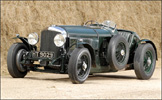 |
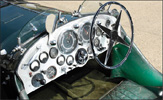 |
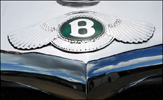 |
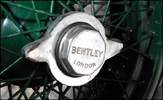 |
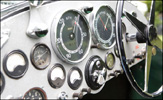 |
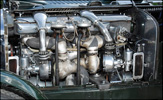 |
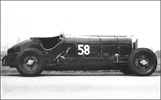 |
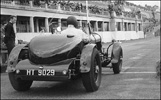 |
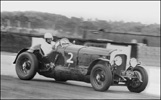 |
|
| |
 |
| |
1924 Bentley 3/8L
Sports Roadster
Est. 550bhp, eight-litre inline
six-cylinder engine with dual SU carburetters
and twin Garrett turbochargers, four-speed
Bentley manual transmission, heavy
duty Bentley 8-Litre live axles, four-wheel
hydraulic brakes. Wheelbase: 117"
(2,972mm).
Bentley Motors has long recruited
eccentric enthusiasts to the brand,
far more so than virtually any other
automaker. This is hardly a shortcoming,
but rather a compliment to the enthusiastic
following Bentley has enjoyed since
the early "Bentley Boys"
era of the heady 1920s.
The late John "Jumbo" Goddard
perhaps epitomizes the ingenuity uniquely
possessed by Bentley enthusiasts better
than anyone else, with the notable
exception of W.O. Bentley himself.
Goddard admired the factory's ability
to produce high-performance machines
with the kind of British soul and
passion that few automakers have possessed
since.
A devotee of the storied marque as
early as the 1920s, the Australian
was immediately attracted to the Bentley
3-Litre. For its time, the 3-Litre
was a respected high performance machine
that featured an 80 horsepower four-cylinder,
16 valve, fixed-head motor with a
single overhead camshaft and a single
carburetter. Jumbo Goddard found all
of this performance highly intriguing
and, in 1928 as a young apprentice
marine engineer living in London,
he purchased a used 1924 3-Litre for
the princely sum of 350 pounds.
His newly acquired Bentley 3-Litre
featured an open sports tourer body
mounted on a lengthy 130 inch wheelbase
and, of course, Bentley's three-litre
four-cylinder powerplant under the
bonnet. When Goddard bought the Bentley,
chassis number 458, it still had a
year of factory warranty coverage.
Goddard was attracted to the girth
and power of these early Bentleys,
produced long before the carmaker
was acquired by Rolls-Royce. A 3-Litre
was of course also the entry point
to the marque that Ettore Bugatti
once quipped built "the fastest
lorries in the world."
It did not take long for the Australian
performance enthusiast to search for
more power from his massive automobile.
First, he brought the car to the Bentley
factory to be fitted with a pair of
SU carburetters and a new inlet manifold.
Although he saw a slight increase
in performance, his appetite was whetted
for more. A Cozette vane-type supercharger
with boost of 4.5 PSI was his next
addition. The supercharger was not
enough to make his 3-Litre a true
"Blower Bentley", of course,
but it kept him satisfied for the
time being.
Goddard stored his Bentley during
the War and, shortly after bringing
it out of storage in 1946, he made
a discovery in a salvage yard that
would forever change not only the
fate of his car, but would bring his
standing from zealous enthusiast to
Bentley performance legend. While
piecing through a yard riddled with
wartime castoffs, he discovered a
military ambulance with a delightful
surprise under its hood: a Bentley
8-Litre motor. After parting with
100 and investing a little bit of
work, he was the proud owner of the
very rare and massive inline six-cylinder
engine.
Just 100 Bentley 8-Litres were produced
before the automaker was acquired
by Rolls-Royce in the difficult Depression
market of 1931. Just how one of the
rare and rather inefficient eight-litre
straight-six motors came to power
an ambulance is somewhat of a mystery,
although there are several reports
of other 8-Litres used in this curious
manner.
Goddard held on to this motor for
eight years before deciding to surprise
the Bentley community by shoehorning
it into his 1924 3-Litre. This was
no easy task, of course, so Goddard
sought the expertise of L.G. McKenzie,
the well-known Rolls-Royce and Bentley
specialist who had made a name for
himself by installing 6½-litre
motors in 4-Litre chassis prior to
the war. Goddard's machine is believed
to be one of two heavily modified
8-Litre projects McKenzie took on.
The 8-Litre Bentley was a remarkable
vehicle conceived in an era of automotive
excess. Curtailed by a slowing global
market that eventually resulted in
the sale of Bentley to Rolls-Royce,
the 8-Litre was to have taken on the
world's best: the Bugatti Royale and
the Rolls-Royce Phantom II. With its
thundering straight-six under the
bonnet, the 8-Litre was capable of
speeds in excess of 160 kilometres
per hour, even with heavy bodywork.
Although its top speed was certainly
very impressive (besting a Phantom
II at speed was easy work for an 8-Litre),
its all-around torque and near-silent
operation made it immensely driveable
from just its top gears. British motoring
publication Autocar commented, in
1930, that the 8-Litre could do its
work on the one [top] gear.
To handle the power, the 8-Litre featured
a substantially strengthened frame
that was shortened to 117 inches.
Goddard's 3-Litre frame was therefore
boxed by being fused together with
another 3-Litre frame. The new motor
was overhauled and installed in the
heavy duty chassis with a pair of
8-Litre axles and telescopic dampers.
Panelcraft created a new, unique and
extremely sporty body for the car
and Goddard had the foresight to include
hydraulic brakes, a rather important
addition in such a powerful car.
It was with this new performance machine
that Goddard would go on to drive
the Flying Kilometer at Antwerp, Belgium
in 1962. With an overall mean speed
of 219.5 kilometres per hour and a
best one-way sprint of 222 kilometres
per hour, the massive Bentley was
certainly a formidable performer.
As would be expected, Goddard, ever
the eccentric Bentley collector and
automotive enthusiast, was unsatisfied
with above-average speeds. In fact,
such a daring attempt at Ghent proved
to be the start of a much larger and
even more ambitious project.
Goddard managed to befriend Wilton
Parker, then the vice president of
the Garrett Corporation, makers of
the vaunted Garrett Exhaust Turbo-Charger
for diesel engines. A relatively new
application in gasoline-powered vehicles
in the 1960s, Goddard's Bentley represented
something of an engineering challenge
for Garrett and Don McKenzie, L.G.
McKenzie's son, who had taken over
the project.
Construction of the twin-turbocharged
Goddard Bentley spanned three continents;
the car remained in London, Goddard
in Australia and most of the technical
development was handled by Garrett
in Los Angeles. Upon completion, the
twin exhaust turbochargers and the
tremendous work done to make them
effective in the gargantuan engine
produced a tremendous 550 horsepower
at 4,000 rpm. The turbo boost remains
at a pre-set 12 pounds, and the Bentley
produces an astonishing 200 horsepower
to the wheels at just 2,000 rpm, barely
above the 1,500 rpm idle speed.
Upon viewing Goddard's final product
shortly before his passing in 1971,
W.O. Bentley is reported to have said,
"You know, this is just the course
of development that would have taken
place if only we had stayed in business."
To say that Jumbo Goddard was of the
same state of mind as the Bentley
Boys is, clearly, an understatement.
Not surprisingly, Goddard returned
to Ghent in the hopes of breaking
his old speeds and arrived at the
Flying Kilometer once more in 1972.
He equipped the car with Dunlop 6.5
x 18 inch racing tyres in front and
Firestone 7.5 x 20 inch tyres in back,
which managed to give the car a uniquely
low stance, even if the choice in
tires was intended more for stability
at speed than for appearance. Retaining
the D-type four-speed manual transmission
and Borg and Beck clutch from the
8-Litre ambulance, the massaged 550
horsepower motor gave the gearbox
quite a workout, so it took a bit
of effort to get the right oil for
the job. Likewise, the huge engine
ran considerably hotter than it did
during its war service, so a pair
of scoops were built into the left
side of the bonnet and a pair of Kenlowe
fans were fitted as well. The Bentley
was painted racing green and to a
most casual observer, it would have
looked merely like a standard Bentley
of the era. Yet up close, the custom
elements were immediately obvious
to anyone familiar with the marque.
The twin-turbocharged Bentley, which
looked little like it did in 1924
when it was a mere 40 horsepower Bentley
3-Litre, smashed through the existing
record and recorded an astounding
254.6 kilometres per hour. In fact,
this record remained unbroken for
many years to come. The fact that
this record was accomplished by what
started life as a 1924 3-Litre is
all the more impressive.
Goddard continued to enjoy the car
as he grew older, and remained an
especially active member of the international
Bentley community, particularly in
Australia. He passed away in 1983
and the car remained with his widow
until the late 1990s. It was then
recorded with the BDC until 2005,
owned in the UK. One year later it
was sold to Germany by Stanley Mann.
John 'Jumbo' Goddard died in 1983
and the car remained with his widow
until the late 1990s. It was then
recorded with the BDC until 2005,
owned in the UK. In 2006, after a
stint at the Donington Park museum,
it was sold to Germany by Stanley
Mann.
With approximately 550 horsepower,
the ex-Jumbo Goddard 1924 Bentley
3/8-Litre on offer is an exceedingly
unique vehicle that truly represents
the spirit invested in Bentley vehicles
by the company's respected founder,
W.O. Bentley. It remains in much the
same condition as when Goddard completed
his project in the mid-1970s, featuring
the 8-Litre ambulance motor, the custom-boxed
frame, the Panelcraft two-seat body
and the black leather interior.
Given that the vehicle was part of
Goddard's extensive collection, it
should come as no surprise that it
was meticulously maintained and enthusiastically
enjoyed whenever possible. The Bentley
has been enjoyed at Brooklands recently
and remains well-suited for road and
track use alike.
The body shows some light wear, as
is to be expected given the vehicle's
use, but the racing green paint presents
very well and the body panels are
straight and purposeful. With a wheelbase
stretching well over nine feet in
length, the Bentley has been a welcome
and crowd-drawing participant at numerous
show events.
A dashboard replete with numerous
instruments is highlighted by a pair
of massive dials for the speedometer
and the tachometer. In many cars,
the 240 kilometre per hour speedometer,
which shows numbered increments of
30 miles or 50 kilometres per hour,
would be quite optimistic. Thanks
to Goddard's imagination and ability,
the eight-litre motor is capable of
such triple-digit speeds on a closed
course. As presented, the car also
retains its massive dual exhaust turbochargers
designed for specifically for this
application, and remaining fully functional.
The brainchild of one of the most
quintessentially eccentric Bentley
enthusiasts to date, this 1924 Bentley
3/8-Litre is unlike anything else
in the world. To imply that it represents
the rare opportunity to acquire one
of the most unique, well-engineered
automobiles of its era is far from
an overstatement. Rather, this automobile
represents an international effort
to continue the spirit of Bentley's
illustrious founder in a manner that
would certainly have been met with
approval and admiration from all of
the original Bentley Boys. |
|
| |
|
|
| |
|
|
| |
Source:
RM Auctions
Posted: Sep 23, 2008 |
|
| |
|
|
|
|
 |
|
|
 |
 |
| 2006 |
| In
Germany in 2006 / Owned by a BDC member |
 |
|
 |
|
|
 |
| Click
on thumbnail for larger view |
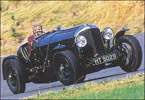 |
|
|
|
| |
 |
| |
|
|
| |
|
|
| |
|
|
| |
Source:
From article, Blown
Away Published in "Classic
& Sports Cars", May 2000
Posted: May 12, 2008 |
|
| |
|
|
|
|
 |
|
 |
|
|
 |
| Click
on thumbnail for larger view |
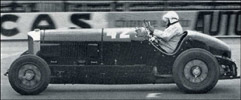 |
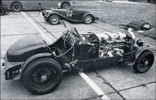 |
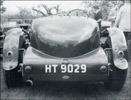 |
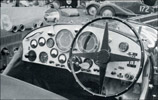 |
|
|
|
| |
 |
| |
This "bolide"
originally started life as a 1924
9 ft. 9 1/2 in. wheelbase 3-litre,
registered HT 9029, and purchased
by her present owner in 1928, with
one year of the company's five-year
guarantee then yet to run.
First experimenting with a Cozette
blower, her speed was increased to
95 mph. Then in 1929 a 6 1/2-litre
engine was acquired and fitted, with
some rearrangement of the chassis
frame, but the extra weight (now up
to 2 tons) offset any advantage of
the 6 cylinder engine's greater power,
with no increase in maximum speed.
After the war Mr. Goddard obtained
an 8-litre engine, and this was handed
over to the then High Priest of Bentleys,
the late L. C. McKenzie, and in this
rebuilt guise she achieved 138 mph
at Antwerp in 1962.
However John Goddard was still not
satisfied, and twin Exhaust Turbo-Chargers,
manufactured by the Sumett Corporation
Inc. of California, were added to
form its present means of induction.
These latest modifications were carried
out by Donald McKenzie (son of L.
C.) and his partner Douglas Guppy,
who have now boosted the power given
to 500 hp at 4,000 rpm with the turbos
rotating at 70,000 revs.
In this form, this the as yet fastest
known Bentley in the world, recorded
158.20 mph for the Flying Kilo at
Ghent in 1972 and in so doing exceeded
160 mph. Fair progress in the same
ownership for 45 years. |
|
| |
|
|
| |
|
|
| |
Source:
Private Motor Car Collections
of Great Britain, Peter Hugo, 1973
Posted: Oct 08, 2007 |
|
| |
|
|
|
|
 |
 |
| 1928 |
| Click
on thumbnail for larger view |
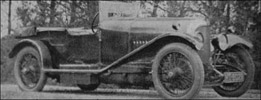 |
|
|
|
| |
 |
| |
|
|
| |
|
|
| |
Source:
RRBEW, New Zealand
Posted: Mar 19, 2013 |
|
| |
|
|
|
|
|
|
 |
| EARLIEST
RECORD OF HISTORICAL FACTS & INFORMATION |
 |
 |
| |
| Chassis No. |
458 |
| Engine No. |
466 |
| Registration
No. |
HT 9029 |
| Date of Delivery: |
Feb 1924 |
| Type of Body: |
4-seater |
| Coachbuilder: |
Cadogan |
| Type of Car: |
SP  |
| |
|
| First Owner: |
PARKER Capt C L
Y |
|
|
| |
|
|
| |
More Info:
Michael Hay, in his book Bentley:
The Vintage Years, 1997, states:
"World's fastest Bentley. Engine
466 supercharged (Cozette blower) then
WB 2553 6½ Litre bored to 7.2 Lites.
Now 8 Litre YR 5100 twin turbochargers.
2 seater by Panelcraft now 2 seater
by ? Flying kilo at 158.20 mph." |
|
| |
|
|
| |
|
|
| |
Posted: Mar 01, 2007 |
|
| |
|
|
|
|
| |
| |
| |
| Submit
more information on this car |
| |
| |
| |
|
|
| |
| |
| |
 |
| |
| |
|
| |
|
 |
 |
 |
Sep 30, 2020 - Info and photograph received from Simon Hunt for Chassis No. RL3439 |
 |
 |
Sep 30, 2020 - Info and photographs received from Dick Clay for Chassis No. 147 |
 |
 |
Sep 29, 2020 - Info and photographs received from Ernst Jan Krudop for his Chassis No. AX1651 |
 |
 |
Sep 28, 2020 - Info and photographs received from Lars Hedborg
for his Chassis No. KL3590 |
 |
 |
Sep 25, 2020 - Info and photograph added for Registration No. XV 3207 |
 |
 |
Sep 24, 2020 - Info and photograph added for Registration No. YM 7165 |
 |
| [More] |
 |
|
|
|
 |
|
|
 |
 |
 |
|
CLUB TALK
Upcoming Vintage Bentley Events |
 |
|
|
 |
 |
 |
|
|
 |
| |
|